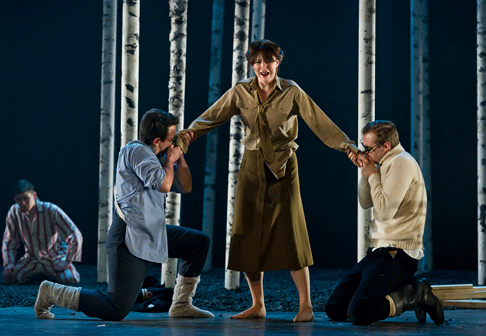01 Mar 2012
A Midsummer Night’s Dream, GSMD
There were high hopes for the 2012 debut production of A Midummer Night’s Dream by the Guildhall School of Music and Drama’s Opera programme .

There were high hopes for the 2012 debut production of A Midummer Night’s Dream by the Guildhall School of Music and Drama’s Opera programme .
Instead of the usual cramped GSMD theatre, this took place in the Barbican Theatre, which allows much more scope for ambitious work, and training in theatre skills, part of the GSMD brief. At the Barbican, young artists of the future have a bigger platform in every way.
A magical effect to begin with. The mechanical curtain was imaginatively clothed in sparkling metal strips. Then, the set revealed a dormitory, perhaps some spartan public school whose fees don’t cover humane accommodation for the inmates. Fair enough, for Britten was traumatized at boarding school, and his music retraces lost innocence over and over again. Then in come the lovers, Demetrius, Lysander, Hermia and Helena appear in 1940’s military garb. Later, Bottom awakes in a bed suspended above the stage. If these images seem familiar, they’re derived. like collage, from several recent professional productions including the ENO, Garsington Opera and Glyndebourne. That’s not in itself a problem, since GSMD students are there to learn.
Perhaps this production was a collaborative effort, involving as many students as possible in the process, but Director Martin Lloyd-Evans might have exerted tighter editorial control to ensure a coherent vision. There are many levels in Shakespeare and in Britten, so A Midsummer Night’s Dream provides wonderful opportunities for young directors and designers to engage with many ideas. This time, though, everyone seemed to be playing safe. The designs (Dick Bird) don’t suggest that much thought has been put into the production. GSMD students are capable of very good work indeed. Read here about their production of Dialogues des Carmélites last year That was outstanding, and would have done credit to a professional house.
When the energy of the cast is engaged, however, there are excellent moments. The mechanicals, in particular, moved precisely, as if in a chorus line, each man perfectly synchronised, arms askew. (Movement by Victoria Newlyn). Very impressive, but individual personalities are not well defined. Not even Bottom, whom Shakespeare singles out for special treatment. It’s a wonderful role, which Barnaby Rea sang well but wasn’t called upon to develop theatrically. The lovers were well done, Ashley Riches’s distinctive voice instantly recognizable, even in anonymous uniform. We need good countertenors and Tom Verney’s Oberon had imposing presence. He’s very young so could well develop an interesting profile. Good singing from the choruses, particularly the quartet of fairies, who were vivacious and well blocked. Given the high calibre of GSMD’s Technical Theatre course participants, one might have expected more imaginative special effects to create the magic the staging lacked. At the Linbury Theatre a few years ago, Puck was played by a circus artist, abseiling from wires, as if he could fly.
 Sky Ingram as Helena, Stuart Laing as Lysander and Ashley Riches as Demetrius
Sky Ingram as Helena, Stuart Laing as Lysander and Ashley Riches as Demetrius
Nonetheless, best for last. Shakespeare and Britten wrote the Mechanical’s stage play with such wit that it’s impossible not to make it effective theatre. Now each singer made his mark, each evidently enjoying himself camping up and having fun. Theseus, Hippolyta and the lovers sneer, but Shakespeare and Britten knew that amateur dramatics have quaint charm.
Anne Ozorio
 The Mechanicals
The Mechanicals